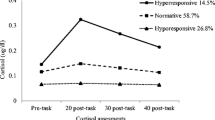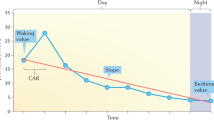Abstract
The aim of our study was to examine whether there are sex-based differences in the relationship between personality traits and hypothalamic–pituitary–adrenal (HPA) axis measures. A total of 106 healthy volunteers (56.6% women; age: 48.0 ± 15.8 years) were studied. The revised temperament and character inventory (TCI-R) and the Childhood Trauma Questionnaire (CTQ) were administered. HPA axis function was assessed using three dynamic measures: the cortisol awakening response (CAR), the diurnal cortisol slope, and the cortisol suppression ratio with 0.25 mg of dexamethasone (DSTR). Female sex was associated with an increased CAR and a more flattened diurnal cortisol slope, although a negative significant interaction between harm avoidance and female sex was found. Regarding the DSTR, perseverance was associated with increased cortisol suppression after dexamethasone; sex did not affect this association. Our study suggests that the relationship between specific personality traits (harm avoidance) and HPA axis measures (CAR, diurnal slope) differs according to sex.


Similar content being viewed by others

References
Abbruzzese EA, Klingmann A, Ehlert U (2014) The influence of the chronotype on the awakening response of cortisol in the morning. Adv Soc Sci Res J 1:115–121. https://doi.org/10.14738/assrj.17.519
Adam EK, Quinn ME, Tavernier R, McQuillan MT, Dahlke KA, Gilbert KE (2017) Diurnal cortisol slopes and mental and physical health outcomes: a systematic review and meta-analysis. Psychoneuroendocrinology 83:25–41. https://doi.org/10.1016/j.psyneuen.2017.05.018
Adan A, Lachica J, Caci H, Natale V (2010) Circadian typology and temperament and character personality dimensions. Chronobiol Int 27:181–193. https://doi.org/10.3109/07420520903398559
Agorastos A, Pervanidou P, Chrousos GP, Kolaitis G (2018) Early life stress and trauma: developmental neuroendocrine aspects of prolonged stress system dysregulation. Hormones (athens) 17:507–520. https://doi.org/10.1007/s42000-018-0065-x
al’Absi M (2006) Hypothalamic-pituitary-adrenocortical responses to psychological stress and risk for smoking relapse. Int J Psychophysiol 59:218–227. https://doi.org/10.1016/j.ijpsycho.2005.10.010
Bernstein DP, Stein JA, Handelsman L (1998) Predicting personality pathology among adult patients with substance use disorders: effects of childhood maltreatment. Addict Behav 23:855–868. https://doi.org/10.1016/S0306-4603(98)00072-0
Christiansen DM, Berke ET (2020) Gender- and sex-based contributors to sex differences in PTSD. Curr Psychiatry Rep 22(4):1523–3812. https://doi.org/10.1007/s11920-020-1140-y
Cloninger CR, Przybeck TR, Swrakic DM (1999) The temperament and character inventory-revised. Washington University, St. Louis
Cloninger CR, Przybeck TR, Svrakic DM (1991) The tridimensional personality questionnaire: U.S. normative data. Psychol Rep 69:1047–1057. https://doi.org/10.2466/pr0.1991.69.3.1047
Clow A, Hucklebridge F, Thorn L (2010) The cortisol awakening response in context Int Rev Neurobiol 93:153–175. https://doi.org/10.1016/S0074-7742(10)93007-9-
Costa PT, McCrae RR (1992) Revised NEO personality inventory (NEO-PIR) and NEO five-factor inventory professional manual. Psychological Assessment Resources, Odessa, TX
Cross D, Fani N, Powers A, Bradley B (2017) Neurobiological development in the context of childhood trauma. Clin Psychol (new York) 24:111–124. https://doi.org/10.1111/cpsp.
Cyniak-Cieciura M, Zawadzki B (2021) The relationship between temperament traits and post-traumatic stress disorder symptoms and its moderators: meta-analysis and meta-regression. Trauma Violence Abuse 22(4):702–716. https://doi.org/10.1177/1524838019876702
DeSoto MC, Salinas M (2015) Neuroticism and cortisol: the importance of checking for sex differences. Psychoneuroendocrinology 62:174–179. https://doi.org/10.1016/j.psyneuen.2015.07.608
Doane LD, Franz CE, Prom-Wormley E, Eaves LJ, Mendoza SP, Hellhammer DH, Lupien S, Xian H, Lyons MJ, Kremen W, Jacobson KC (2011) Negative emotionality, depressive symptoms and cortisol diurnal rhythms: analysis of a community sample of middle-aged males. Horm Behav 60:202–209. https://doi.org/10.1016/j.yhbeh.2011.05.003
Ferguson E (2008) Health anxiety moderates the daytime cortisol slope. J Psychosom Res 64:487–494. https://doi.org/10.1016/j.jpsychores.2008.01.011
Ferrari E, Cravello L, Muzzoni B, Casarotti D, Paltro M, Solerte SB, Fioravanti M, Cuzzoni G, Pontiggia B, Magri F (2001) Age-related changes of the hypothalamic-pituitary-adrenal axis: pathophysiological correlates. Eur J Endocrinol 144:319–329. https://doi.org/10.1530/eje.0.1440319
De Fruyt F, Van De Wiele L, Van Heeringen C (2000) Cloninger’s psychobiological model of temperament and character and the five-factor model of personality. Pers Individ Dif.https://doi.org/10.1016/S0191-8869(99)00204-4
Gerra G, Zaimovic A, Timpano M, Zambelli U, Delsignore R, Brambilla F (2000) Neuroendocrine correlates of temperamental traits in humans. Psychoneuroendocrinology 25:479–496
Gervasio J, Zheng S, Skrotzki C, Pachete A (2022) The effect of oral contraceptive use on cortisol reactivity to the Trier social stress test: a meta-analysis. Psychoneuroendocrinology 136:105626. https://doi.org/10.1016/j.psyneuen.2021.105626
Goel N, Workman JL, Lee TT, Innala L, Viau V (2014) Sex differences in the HPA axis. Compr Physiol 4:1121–1155. https://doi.org/10.1002/cphy.c130054
Gutierrez-Zotes A, Labad J, Martorell L, Gaviria A, Bayón C, Vilella E, Cloninger CR (2015) The revised temperament and character inventory: normative data by sex and age from a Spanish normal randomized sample. PeerJ 3:e1481. https://doi.org/10.7717/peerj.1481
Hauner KKY, Adam EK, Mineka S, Doane LD, DeSantis AS, Zinbarg R, Craske M, Griffith JW (2008) Neuroticism and introversion are associated with salivary cortisol patterns in adolescents. Psychoneuroendocrinology 33:1344–1356. https://doi.org/10.1016/j.psyneuen.2008.07.011
Hengartner MP, Cohen LJ, Rodgers S, Müller M, Rössler W, Ajdacic-Gross V (2015) Association between childhood maltreatment and normal adult personality traits: exploration of an understudied field. J Pers Disord 29:1–14. https://doi.org/10.1521/pedi_2014_28_143
Hill EM, Billington R, Krägeloh C (2013) The cortisol awakening response and the big five personality dimensions. Pers Individ Dif 55:600–605. https://doi.org/10.1016/j.paid.2013.05.010
Hilt LM, Sladek MR, Doane LD, Stroud CB (2017) Daily and trait rumination: diurnal cortisol patterns in adolescent girls. Cogn Emot 31:1757–1767. https://doi.org/10.1080/02699931.2016.1262332
Hori H, Teraishi T, Sasayama D, Hattori K, Hashikura M, Higuchi T, Kunugi H (2013) Relationship of temperament and character with cortisol reactivity to the combined dexamethasone/CRH test in depressed outpatients. J Affect Disord 147(1–3):128–136. https://doi.org/10.1016/j.jad.2012.10.022
Kajantie E, Phillips DIW (2006) The effects of sex and hormonal status on the physiological response to acute psychosocial stress. Psychoneuroendocrinology 31:151–178. https://doi.org/10.1016/j.psyneuen.2005.07.002
Kirschbaum C, Kudielka BM, Gaab J, Schommer NC, Hellhammer DH (1999) Impact of gender, menstrual cycle phase, and oral contraceptives on the activity of the hypothalamus-pituitary-adrenal axis. Psychosom Med 61:154–162. https://doi.org/10.1097/00006842-199903000-00006
Kuzminskaite E, Penninx BWJH, van Harmelen AL, Elzinga BM, Hovens JGFM, Vinkers CH (2021) Childhood trauma in adult depressive and anxiety disorders: an integrated review on psychological and biological mechanisms in the NESDA cohort. J Affect Disord 15(283):179–191. https://doi.org/10.1016/j.jad.2021.01.054
Laceulle OM, Nederhof E, van Aken MAG, Ormel J (2015) Adolescent personality: associations with basal, awakening, and stress-induced cortisol responses. J Pers 83:262–273. https://doi.org/10.1111/jopy.12101
Liening SH, Stanton SJ, Saini EK, Schultheiss OC (2010) Salivary testosterone, cortisol, and progesterone: two-week stability, interhormone correlations, and effects of time of day, menstrual cycle, and oral contraceptive use on steroid hormone levels. Physiol Behav 99:8–16. https://doi.org/10.1016/j.physbeh.2009.10.001
Lobo A, Pérez-Echeverría MJ, Artal J (1986) Validity of the scaled version of the General Health Questionnaire (GHQ-28) in a Spanish population. Psychol Med 16:135–140
Lucassen EA, Cizza G (2012) The hypothalamic-pituitary-adrenal axis, obesity, and chronic stress exposure: sleep and the HPA axis in obesity. Curr Obes Rep 1(4):208–215. https://doi.org/10.1007/s13679-012-0028-5
Meulenberg PM, Hofman JA (1990a) The effect of oral contraceptive use and pregnancy on the daily rhythm of cortisol and cortisone. Clin Chim Acta 190:211–221. https://doi.org/10.1016/0009-8981(90)90175-r
Meulenberg EP, Hofman JA (1990b) The effect of pretreatment of saliva on steroid hormone concentrations. J Clin Chem Clin Biochem 28(12):923–928. https://doi.org/10.1515/cclm.1990.28.12.923
Miettunen J, Veijola J, Lauronen E, Kantojärvi L, Joukamaa M (2007) Sex differences in Cloninger's temperament dimensions--a meta-analysis. Compr Psychiatry 83:262–273. https://doi.org/10.1016/j.comppsych.2006.10.007
Miller R, Plessow F (2013) Transformation techniques for cross-sectional and longitudinal endocrine data: application to salivary cortisol concentrations. Psychoneuroendocrinology 38:941–946. https://doi.org/10.1016/j.psyneuen.2012.09.013
Mohiyeddini C, Bauer S, Semple S (2015) Neuroticism and stress: the role of displacement behavior. Anxiety Stress Coping 28:391–407. https://doi.org/10.1080/10615806.2014.1000878
Nostro AD, Müller VI, Reid AT, Eickhoff SB (2017) Correlations between personality and brain structure: a crucial role of gender. Cereb Cortex 27:3698–3712. https://doi.org/10.1093/cercor/bhw191
Ormel J, Bastiaansen A, Riese H, Bos EH, Servaas M, Ellenbogen M, Rosmalen JGM, Aleman A (2013) The biological and psychological basis of neuroticism: current status and future directions. Neurosci Biobehav Rev 37:59–72. https://doi.org/10.1016/j.neubiorev.2012.09.004
Oswald LM, Zandi P, Nestadt G, Potash JB, Kalaydjian AE, Wand GS (2006) Relationship between cortisol responses to stress and personality. Neuropsychopharmacology 31:1583–1591 https://doi.org/10.1038/sj.npp.1301012-
Polk DE, Cohen S, Doyle WJ, Skoner DP, Kirschbaum C (2005) State and trait affect as predictors of salivary cortisol in healthy adults. Psychoneuroendocrinology 30:261–272. https://doi.org/10.1016/j.psyneuen.2004.08.004
Portella MJ, Harmer CJ, Flint J, Cowen P, Goodwin GM (2005) Enhanced early morning salivary cortisol in neuroticism. Am J Psychiatry 162:807–809. https://doi.org/10.1176/appi.ajp.162.4.807
Pruessner JC, Kirschbaum C, Meinlschmid G, Hellhammer DH (2003) Two formulas for computation of the area under the curve represent measures of total hormone concentration versus time-dependent change. Psychoneuroendocrinology 28:916–31. https://doi.org/10.1016/S0306-4530(02)00108-7
Rademaker AR, Kleber RJ, Geuze E, Vermetten E (2009) Personality dimensions harm avoidance and self-directedness predict the cortisol awakening response in military men. Biol Psychol 81:177–183. https://doi.org/10.1016/j.biopsycho.2009.04.002
Salvat-Pujol N, Labad J, Urretavizcaya M, de Arriba-Arnau A, Segalàs C, Real E, Ferrer A, Crespo JM, Jiménez-Murcia S, Soriano-Mas C, Menchón JM, Soria V (2017) Hypothalamic-pituitary-adrenal axis activity and cognition in major depression: the role of remission status. Psychoneuroendocrinology 76:38–48. https://doi.org/10.1016/j.psyneuen.2016.11.00
van Santen A, Vreeburg SA, Van der Does AJW, Spinhoven P, Zitman FG, Penninx BWJH (2011) Psychological traits and the cortisol awakening response: results from the Netherlands study of depression and anxiety. Psychoneuroendocrinology 36:240–248 https://doi.org/10.1016/j.psyneuen.2010.07.014
Schommer NC, Kudielka BM, Hellhammer DH, Kirschbaum C (1999) No evidence for a close relationship between personality traits and circadian cortisol rhythm or a single cortisol stress response. Psychol Rep 84:840–842. https://doi.org/10.2466/pr0.84.3.840-842Po
Stalder T, Kirschbaum C, Kudielka BM, Adam EK, Pruessner JC, Wüst S, Dockray S, Smyth N, Evans P, Hellhammer DH, Miller R, Wetherell MA, Lupien SJ, Clow A (2016) Assessment of the cortisol awakening response: expert consensus guidelines. Psychoneuroendocrinology 63:414–432. https://doi.org/10.1016/j.psyneuen.2015.10.010
Tyrka AR, Wier LM, Anderson GM, Wilkinson CW, Price LH, Carpenter LL (2007) Temperament and response to the Trier social stress test. Acta Psychiatr Scand 115:395–402
Tyrka AR, Wier LM, Price LH, Rikhye K, Ross NS, Anderson GM, Wilkinson CW, Carpenter LL (2008) Cortisol and ACTH responses to the Dex/CRH test: influence of temperament. Horm Behav 53:518–525. https://doi.org/10.1016/j.yhbeh.2007.12.004
Tyrka AR, Mello AF, Mello MF, Gagne GG, Grover KE, Anderson GM, Price LH, Carpenter LL (2006) Temperament and hypothalamic-pituitary-adrenal axis function in healthy adults. Psychoneuroendocrinology 31:1036–1045 https://doi.org/10.1016/j.psyneuen.2006.06.004
Zobel A, Barkow K, Schulze-Rauschenbach S, Von Widdern O, Metten M, Pfeiffer U, Schnell S, Wagner M, Maier W (2004) High neuroticism and depressive temperament are associated with dysfunctional regulation of the hypothalamic-pituitary-adrenocortical system in healthy volunteers. Acta Psychiatr Scand 109:392–399. https://doi.org/10.1111/j.1600-0447.2004.00313.x
Acknowledgements
The authors express their gratitude to all of the study participants, as well as to the staff of the Department of Psychiatry at Bellvitge University Hospital who contributed to recruiting the sample. We are also very grateful to Anna Ferrer and Maria Badia from the Pharmacy Department at Bellvitge University Hospital for providing the 0.25 mg dexamethasone capsules, the staff of Biopsychology at the Department of Psychology of the Technische Universität Dresden for analyzing salivary cortisol samples, and the technicians from the Biobank IISPV and the Biobank HUB-ICO-IDIBELL.
Funding
This study was supported in part by grants from the Carlos III Health Institute through the Ministry of Science, Innovation, and Universities (PI10/01753, PI19/01040, INT21/00055), the European Regional Development Fund (ERDF) “A way to build Europe,” CIBERSAM, and the Catalan Agency for the Management of University and Research Grants (AGAUR 2017 SGR 1247 and 2017 SGR 632). Samples from subjects included in this study were processed and preserved by the Biobank IISPV and the Biobank HUB-ICO-IDIBELL, integrated into the Spanish National Biobanks Network (PT17/0015/0024), and Xarxa Banc de Tumors. We also thank CERCA Programme/Generalitat de Catalunya for institutional support.
Author information
Authors and Affiliations
Corresponding author
Ethics declarations
Conflict of interest
The authors declare no competing interests.
Additional information
Publisher's note
Springer Nature remains neutral with regard to jurisdictional claims in published maps and institutional affiliations.
Supplementary Information
Below is the link to the electronic supplementary material.
Rights and permissions
About this article
Cite this article
Monreal, J.A., Salvat-Pujol, N., González-Rodríguez, A. et al. The relationship between sex, personality traits, and the hypothalamic-pituitary-adrenocortical axis. Arch Womens Ment Health 25, 693–703 (2022). https://doi.org/10.1007/s00737-022-01241-9
Received:
Accepted:
Published:
Issue Date:
DOI: https://doi.org/10.1007/s00737-022-01241-9



